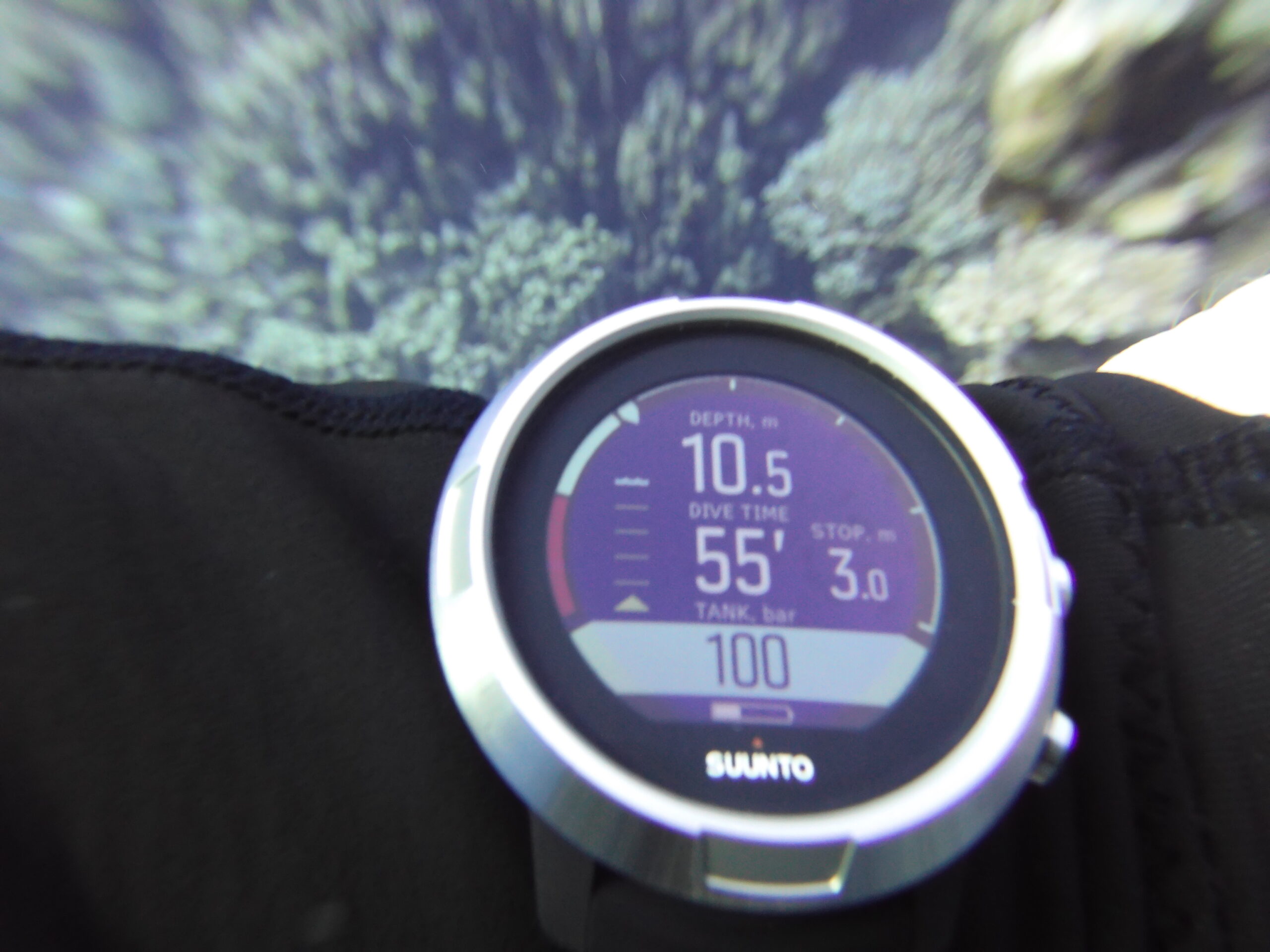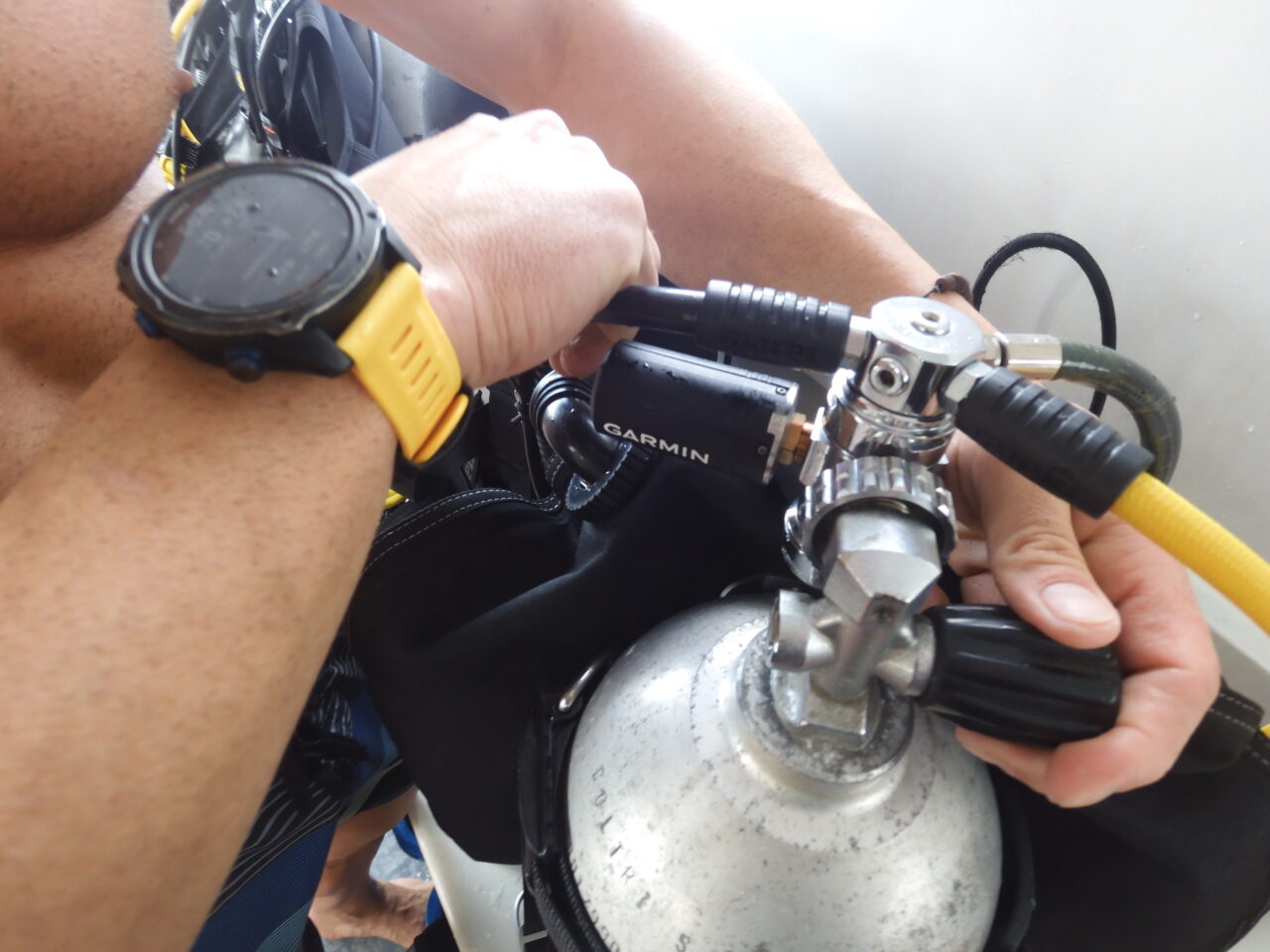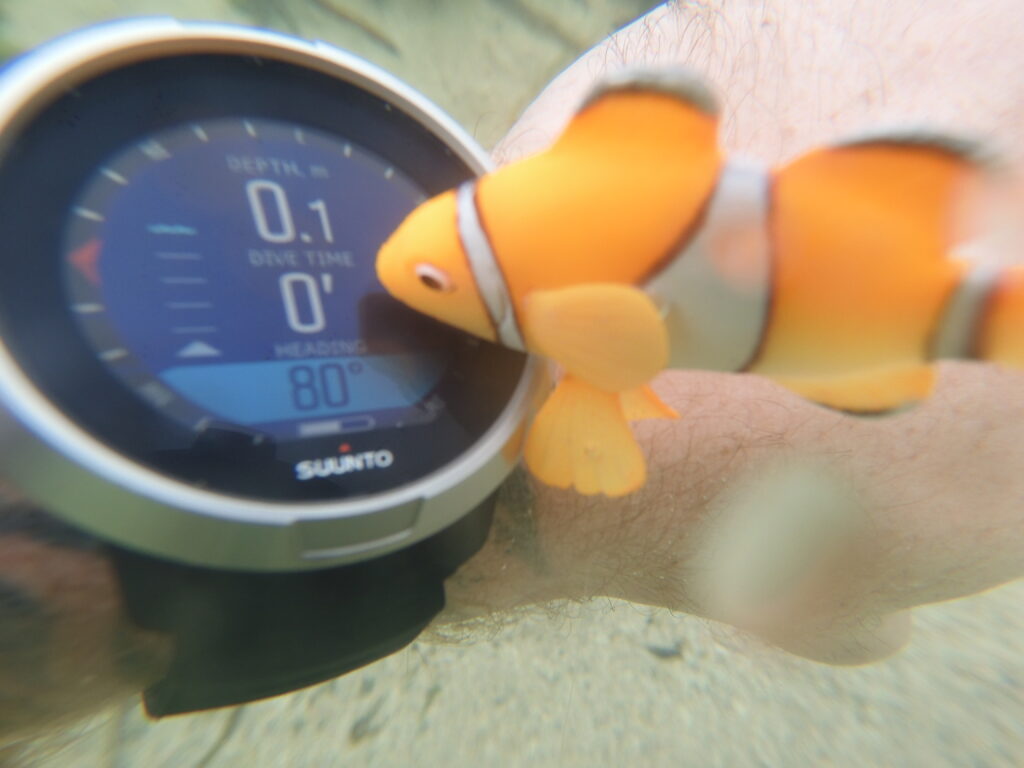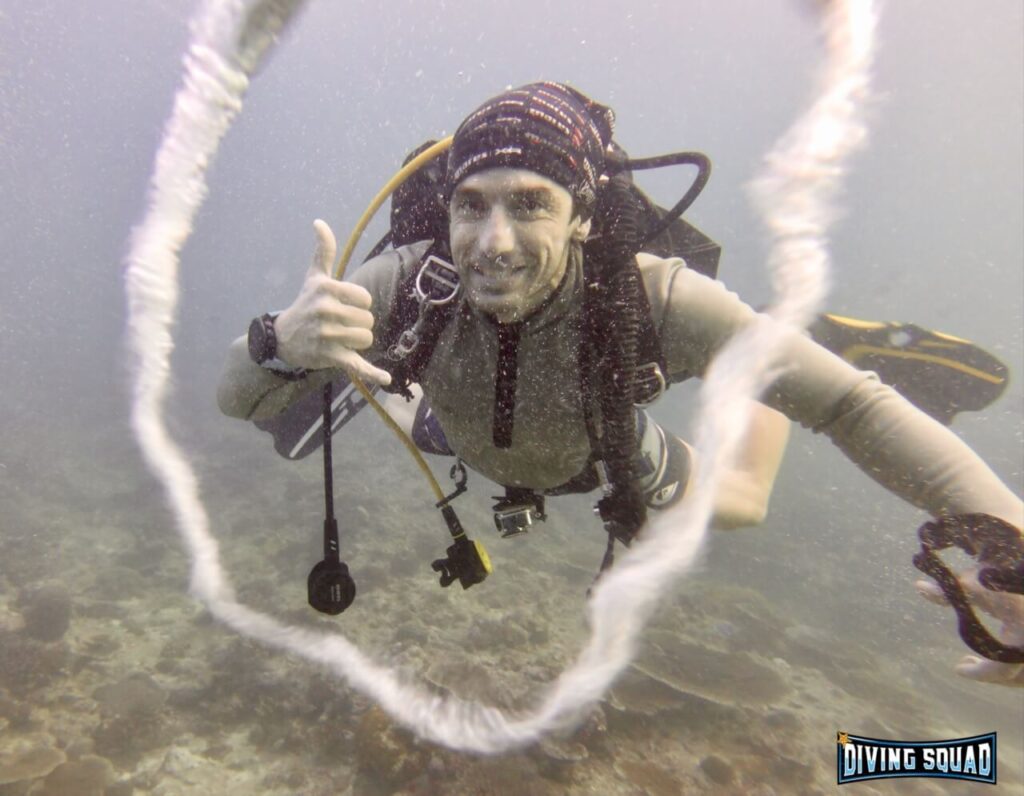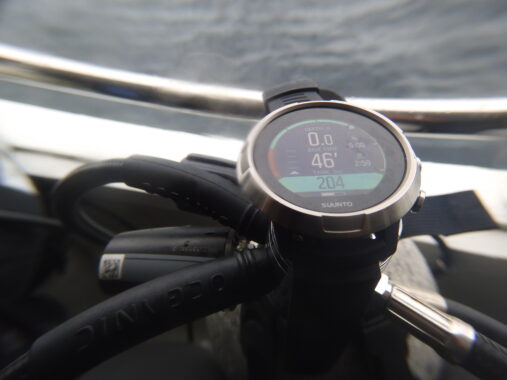
It’s all very well having a regular old dive computer for deco time, depth and safety stop readings…
…but an air integrated dive computer also tells you how much air remains in your tank (i.e. tank pressure) via a wireless transmitter.
This is an absolute game-changer – it’s so much easier seeing your remaining air on a dive computer than it is having to pull out the pressure gauge every time you want to check it.
In this epic guide of awesomeness, we’ve provided firsthand reviews of the best air integrated dive computers available in 2025.
Dive down to the QUICK ANSWER for a rapid breakdown of each model of air integrated dive computer with links to view on Amazon or scroll down further to read our detailed reviews.
Some air integrated dive computers also show your air consumption rate and use this to provide an AI prediction for how much air time you have remaining.
In my own experience, having an air integrated dive computer leads to a much greater awareness of one’s air consumption rate; this teaches you to control it more carefully and thus makes you a better diver.
The affiliate links we’ve provided send you to the buying page for packages that include the dive computer and wireless transmitter – which you’ll need for the air integration info. Let’s take a look!
QUICK ANSWER – Best Air Integrated Dive Computers for…
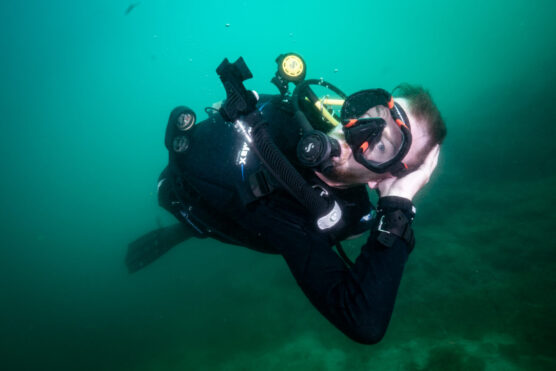
The BEST air integrated dive computer is the Suunto D5 It has plenty of advanced features yet is easy to use and offers awesome value for money.
The most luxurious air integrated dive computer is the the Garmin Descent MK2i which also doubles up as a SmartWatch and has fitness apps! And the cheapest air integrated dive computer is the Mares Smart Air.
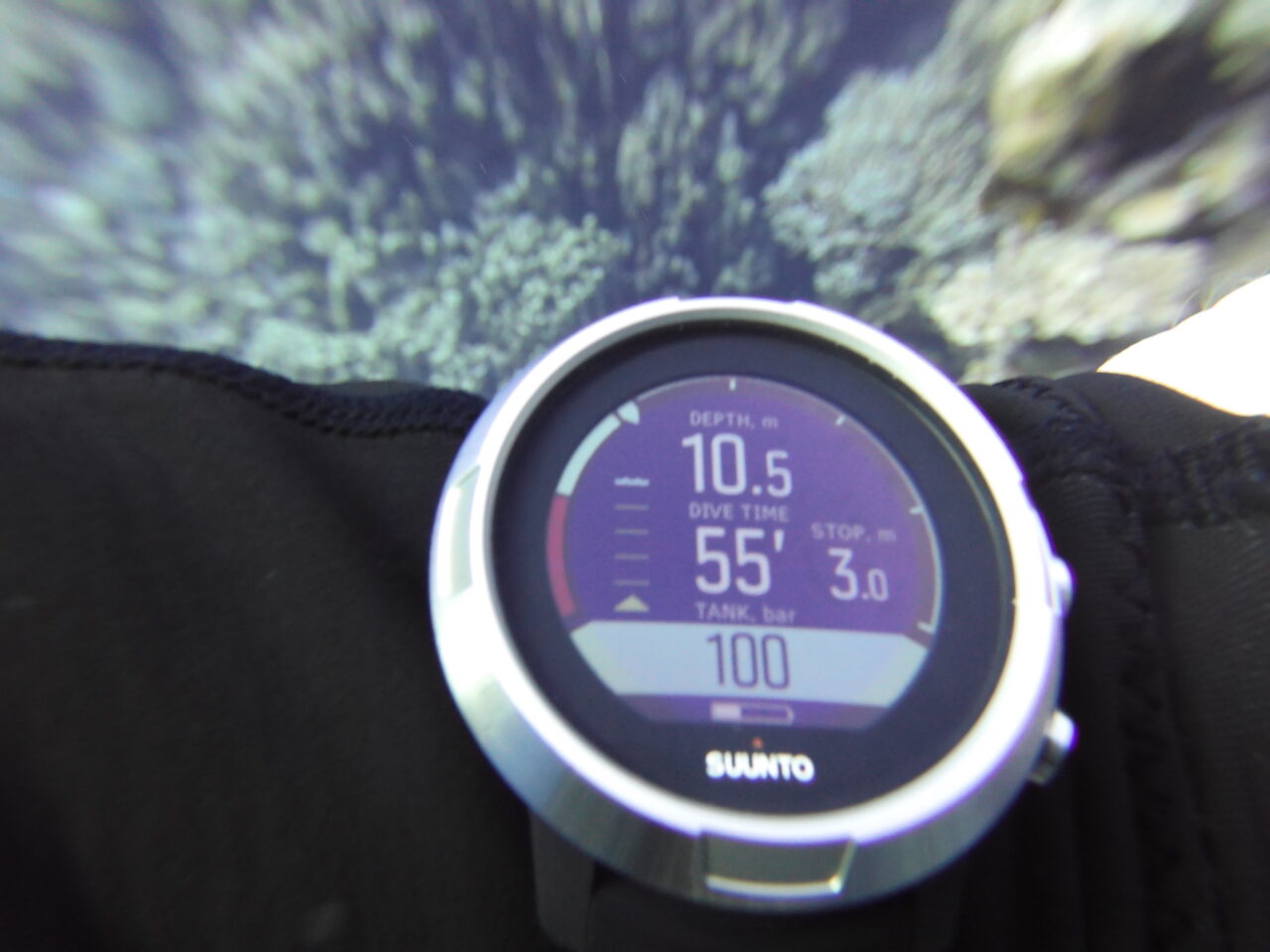
1) Best Air Integrated Dive Computer Overall: Suunto D5
Price: > $$
Air Consumption Rate
Tank Pressure & Remaining Air Time
Full Colour LED Display
Compass
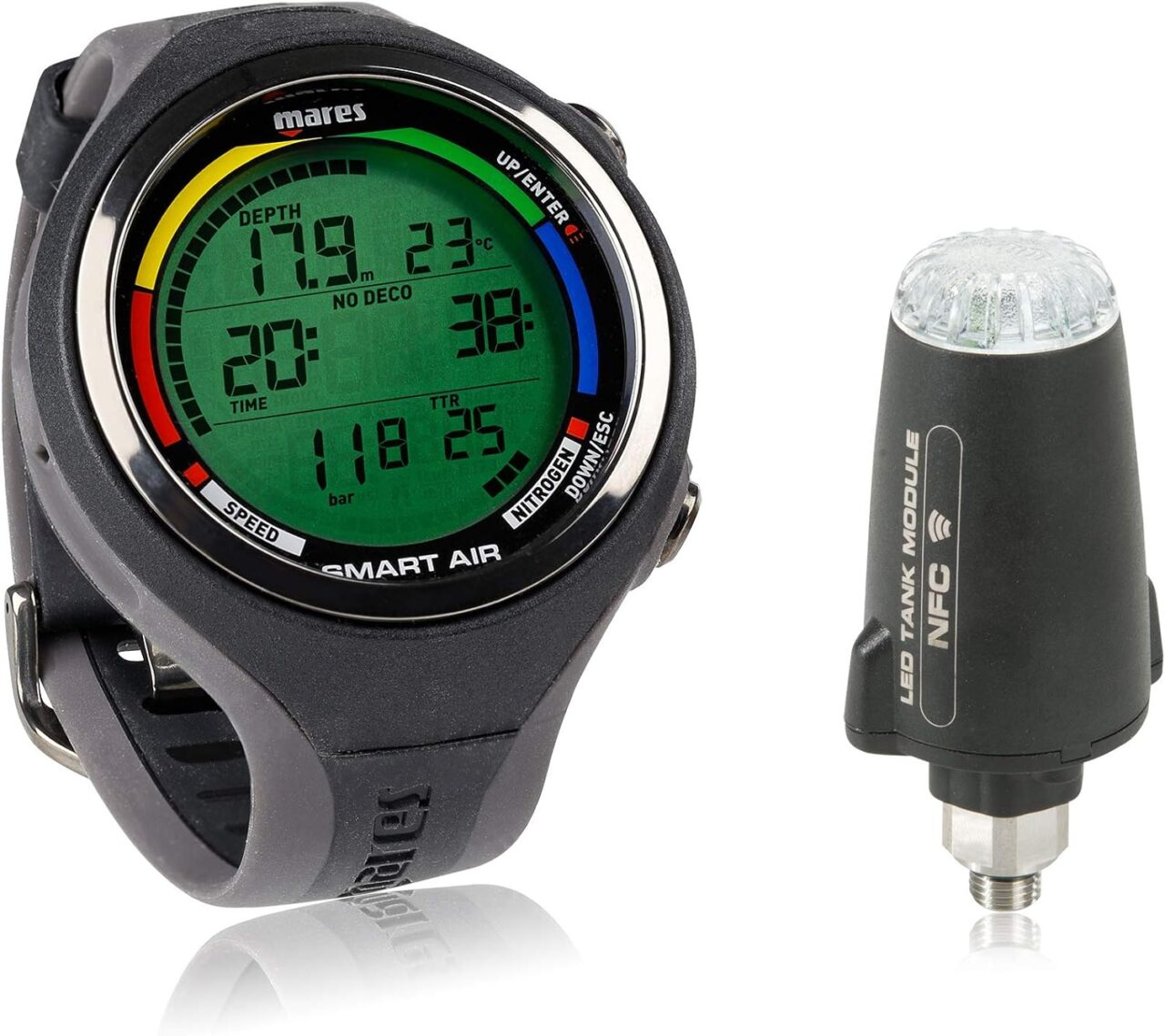
2) Cheapest: Mares Smart Air
Price: > $
Tank Pressure
Dot Matrix Display
Lithium Battery
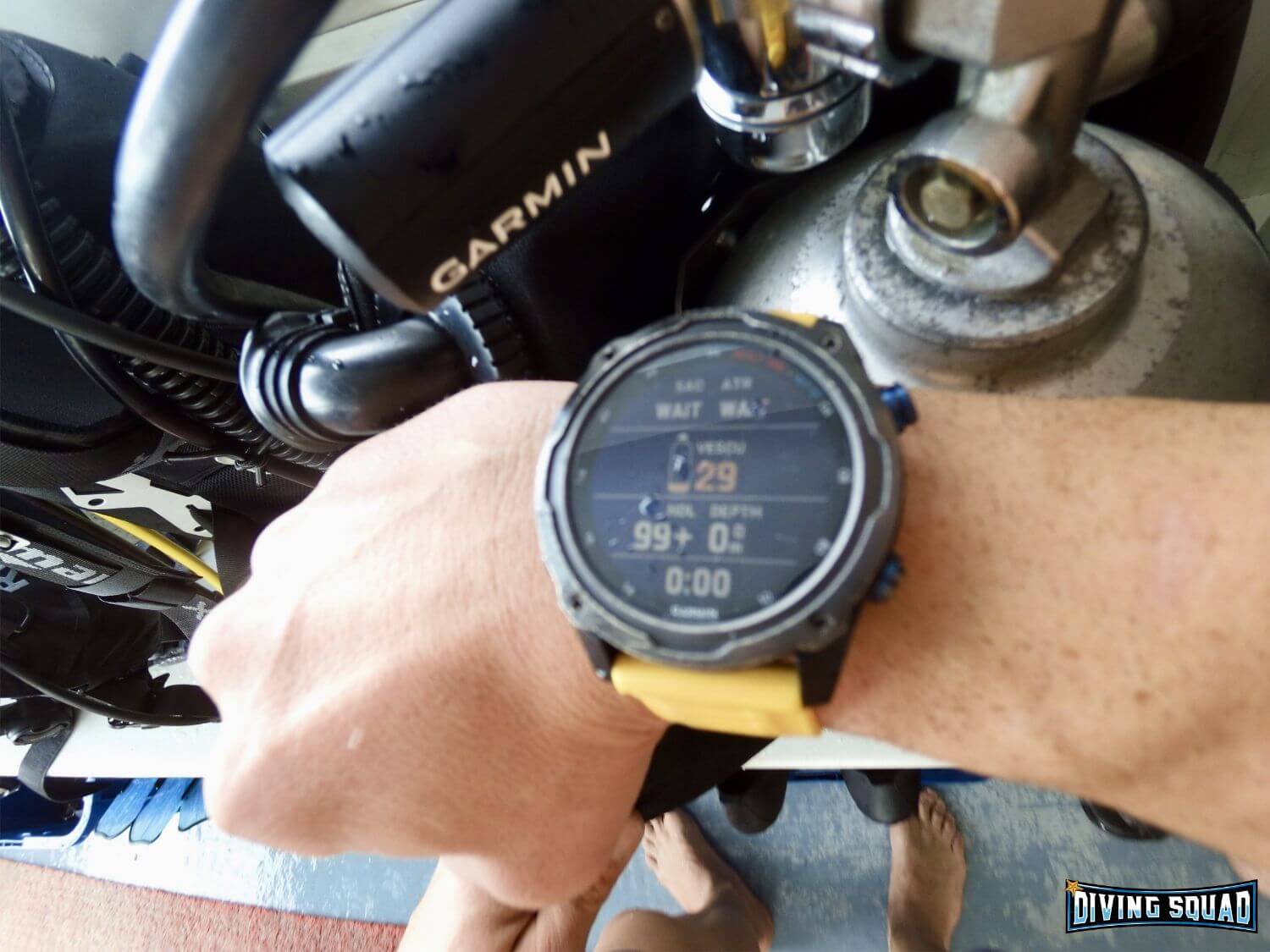
3) Luxury Option: Garmin Descent MK2i
Price: > $$$
Air Consumption Rate
Tank Pressure & Remaining Air TIme
SmartWatch Functions
Full Colour LED Display
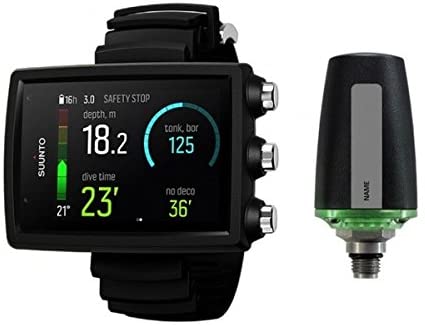
4) Ultra High-Contrast Display: Suunto Eon Core
Price: > $$$
HD Coloured Coded Rectangular Display
Tank Pressure & Remaining Air Time
Air Consumption Rate
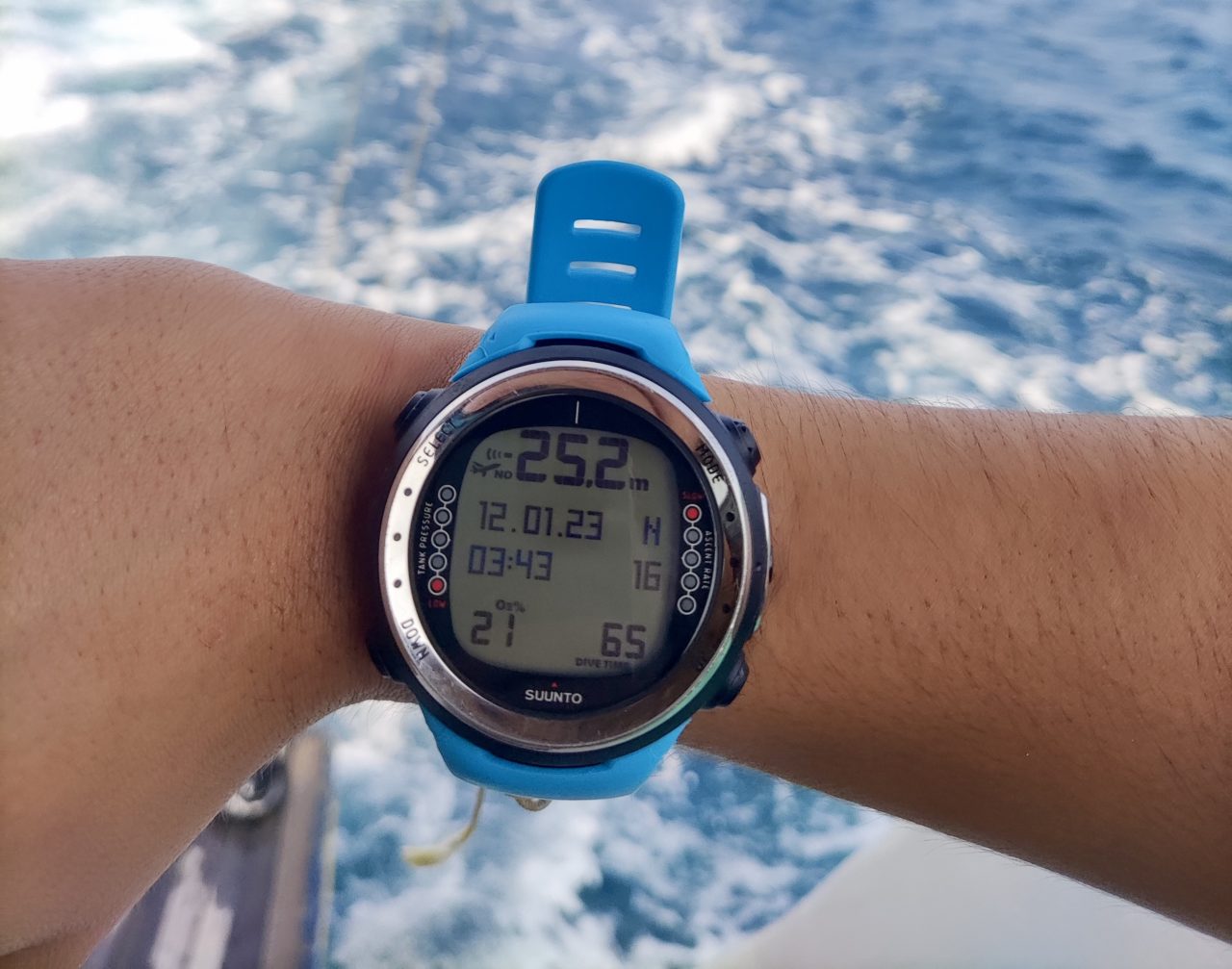
5) Best Mid-Pricer: Suunto D4i
Price: > $$
Second Cheapest Option
Tank Pressure & Remaining Air Time
Dot Matrix Display
Watch Sized
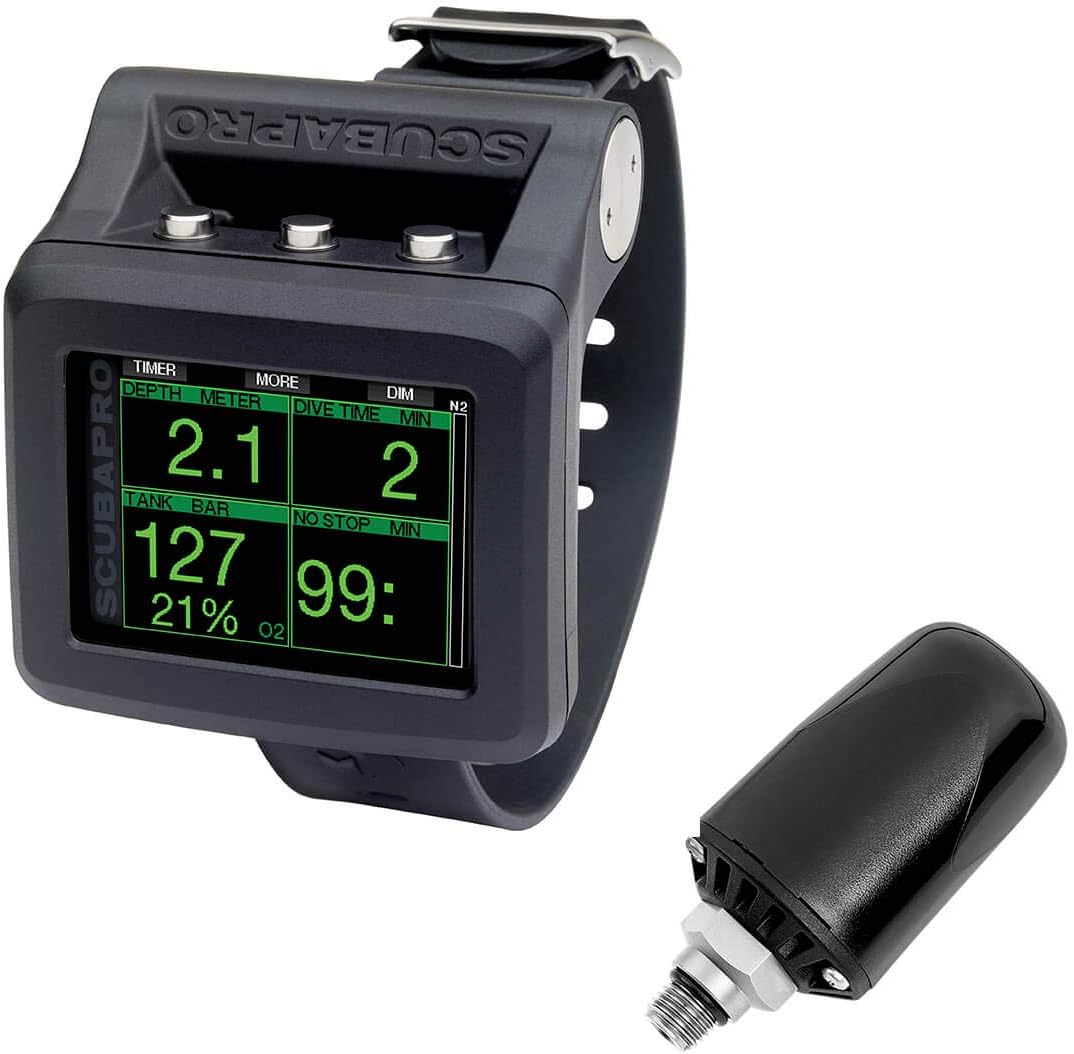
6) Alternative Design: ScubaPro G2
Price: > $$$
Rectangular Design with Split Display
Tank Pressure & Remaining Air
Air Consumption Rate
Huge Log Book (1000 hours)
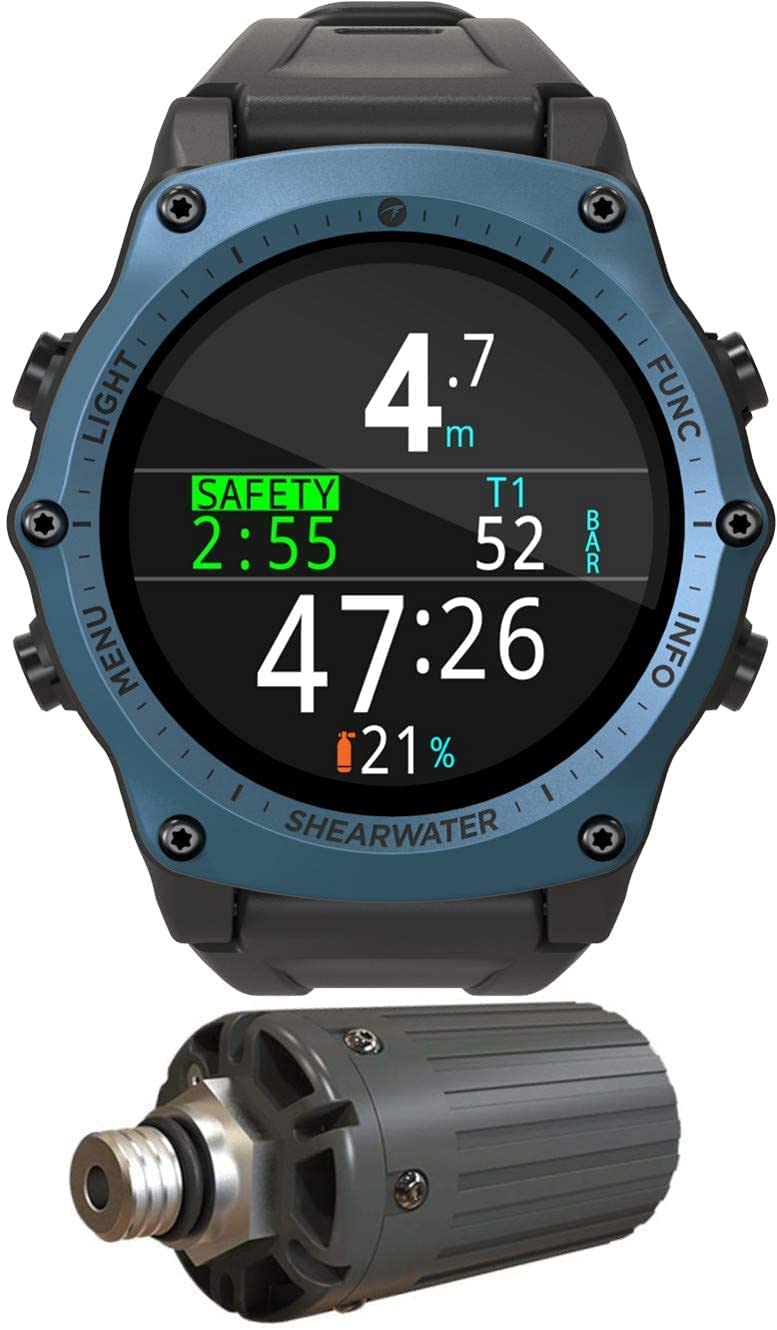
7) For Tec Divers: Shearwater Teric
Price: > $$$
Dedicated Tec Mode
Tank Pressure & Remaining Air
Air Consumption Rate
LED High Contrast Display
Real-Life Reviews:
- Top Pick: Suunto D5
- Cheapest: Mares Smart Air
- Luxury: Garmin Descent MK2i
- Ultra High-Contrast Display: Suunto Eon Core
- Best Mid-Pricer: Suunto D4i
- Alternative Design: ScubaPro G2
- Tec Divers: Shearwater Research Teric
1) Top Pick: Suunto D5
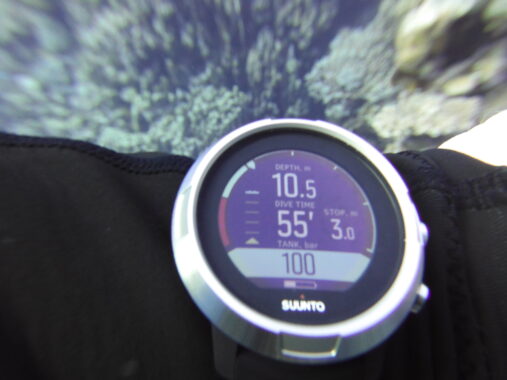
Where to Buy:
The mid-priced Suunto D5 is as light and compact as a watch and has a powerful, colour-coded display.
Unlike more basic air integrated dive computers which only give remaining air, the D5 also shows your air consumption rate per dive in the dive log; which is great for measuring personal progress.
As well as this, it uses AI to provide an in-dive estimate of how long before you finish your remaining air.
This is a quirky and beautiful looking dive computer – with a reinforced composite casing, range of colour options and stainless steel bezel that gives it a somewhat nautical appearance.
Featuring an inbuilt compass, gas-switch compatibility and the option to adjust the algorithm to be more or less conservative, it has plenty of features for advanced divers.
That said, the D5 is actually incredibly easy to use with an extremely intuitive, three button navigation system that even beginners will quickly get used to.
The D5 features a rechargeable battery that should last you around 7 – 8 hours whilst diving. This isn’t quite as long as some other rechargeable dive computers; however it’s made up for by the huge 200 hour dive log.
PROS:
- Calculates Remaining Air Time
- Shows Air Consumption per dive
- HD Colour-Coded Display
- Inbuilt Compass
- Adjustable Algorithm
CONS:
- Battery life is a bit short (around 8 hours diving time)
- You need to recalibrate the compass after charging
2) Cheapest: Mares Smart Air
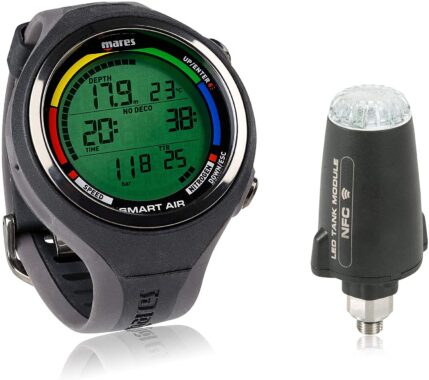
Where to Buy:
It’s a simple reality that air integrated dive computers are more expensive than regular ones.
That said, we’ve scoured the seven seas for the cheapest air integrated dive computer available and it’s the Mares Smart Air which is way more affordable than all other options on the market.
At 7.5 x 5 x 3 inches; the Mares Smart Air is a little more bulky than pricier dive computers and it has a simple dot-matrix display with no colour coding.
However these are small prices to pay for a cheap dive computer that tells you how much remaining air you have in your tank!
Its 2 button user-interface is intuitive and easy to use, even for beginners and it operates to 492 feet / 150 meters deep.
With a user-replaceable lithium battery lasting 100 – 150 dives and a sizeable logbook of up to 95 hours, this is a decent and smart looking dive computer that offers awesome value for money.
PROS:
- Cheapest Air Integrated Dive Computer
- Awesome Value for Money
- Easy to Use
- Decent Sized Log Book
- Good Battery Life
CONS:
- Lack of colour display
- Bulkier than more expensive options
- Can’t shoot 4k at 60 fps
…all of these cons are resolved by the Akaso V50 Elite!
3) Best Luxury Option: Garmin Descent Mk2i
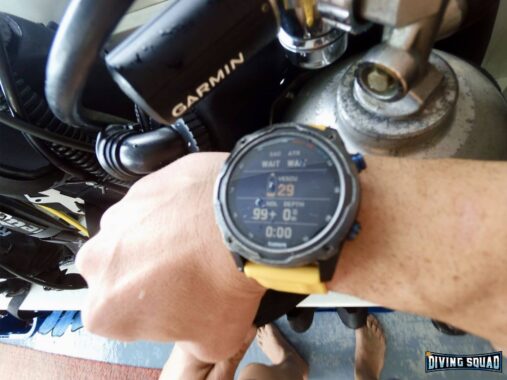
Where to Buy:
The Garmin Descent Mk2i was designed foremost with scuba diving in mind but it also doubles up as a SmartWatch that will thrill fitness freaks and adventurers!
Sailing, backcountry skiing, skydiving and kayaking are just some of the many extra activities it can track with enhanced wrist-based heartbeat estimates.
The TI transmitter provides advanced air integration and ultra accurate remaining air readings as well as remaining dive time and air consumption rate.
With a titanium bezel and backplate for excellent durability and an exceptionally comfortable silicone strap; it’s as compact and light as a regular wrist watch.
The 1.4″, sapphire crystal full-colour display is sunlight readable, setting it apart from other dive computers which can often be hard to read in shallow water or on land.
The colour coded data is intuitive to read and you can select from a range of layouts, including a classical watch style layout with moving hands for telling the time on land.
There’s six dive modes along with multi-GNSS support and ABC sensors along with an underwater compass and a logbook capable of storing up to 200 dives.
It has a rechargeable battery with a whopping duration of 80 hours in dive mode – longer than that of any other dive computer and it can last for up to 16 days in smartwatch mode!
PROS:
- Shows Air Consumption Per Dive
- Calculates Remaining Air Time
- SmartWatch & Fitness Functions
- Longest Rechargeable Battery of any dive computer
- Huge Log Book
CONS:
- Expensive!
4) Ultra High-Contrast Display: Suunto Eon Core

Where to Buy:
With it’s backlit LED display, prominent three buttons, 3D, tilt compensated digital compass and sleek design, the Suunto Eon Core is a perfect option for anyone who prefers a more modern style of air integrated dive computer.
The 5 x 3.8 cm LED display’s brightens can be adjusted and it’s also possible to flip and even re-program it, in order to have data presented exactly how you want.
It gives highly accurate tank pressure (how much air is in your tank) readings as well as air consumption and remaining air time.
Data on the display is presented in an intuitive colour coding system, with large and clear digits. When everything is within normal parameters data is in blue and white; notifications are in yellow and alarms are given in red.
Some users have commented on the display being a bit faded in shallow water but for other divers this isn’t a problem.
Despite it’s futuristic design and appearance, the Suunto Eon Core is a surprisingly easy to use and setup piece of kit. The buttons are easy to press and the setup menu itself is more straightforward than that of most dive computers.
The Eon Core features a magnetic charger with which it takes 5 hours to charge and provides 14 hours at the brightens setting.
PROS:
- Large LED display with adjustable brightness
- 3 axis digital compass
- Bluetooth connectivity
- Air, nitrox and trimix modes
- Show remaining air time
CONS:
- Short battery life (14 hours)
- Screen may appear a little faded when in very shallow water
5) Best Mid-Pricer: SUUNTO D4i Novo
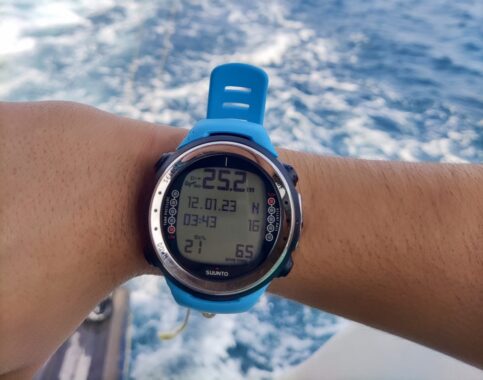
Where to Buy:
The Suunto D4i Novo is the second cheapest option on our list and offers a great combo of decent quality and affordability.
The wireless transmitter air integration tech displays your cylinder pressure on the dot-matrix screen and can also calculate remaining air time.
At 6 x 5 x 5 inches and 230 grams, the D4i Novo is the cheapest dive computer on our list that’s as compact as a watch, meaning you can wear it all day long; knowing you look damn good!
It’s sleek and comfortable to wear, with a silicone strap that is both flexible and comfortable. There four button user-interface is both simple to use and intuitive.
The dive log is an impressive 140 hours long. It would be nice to see an integrated digital compass – but you can’t have everything at only mid-price!
Suunto are an extremely popular brand, well known for making superb mid to high range dive computers.
PROS:
- Same size as a regular watch
- Comfortable and stylish to wear
- gration tech calculates remaining air
- Huge dive log of 140 hours
CONS:
- No digital compass
6) Alternative Design: ScubaPro G2
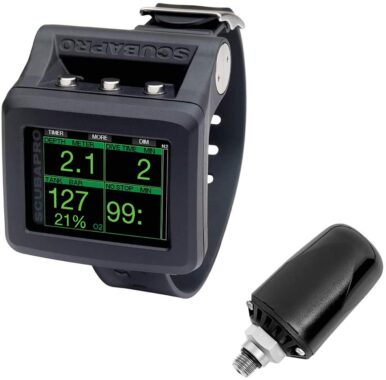
Where to Buy:
The ScubaPro G2 is a high quality air integrated dive computer with some extremely impressive specs that none of the other dive computers we’ve so far reviewed can compete with.
For starters it has an insane logbook capacity of 1000 hours, can go to 393ft deep and the battery life is up to 50 hours per charge; which is way more sensible than the puny 6 – 12 hours charge offered by some of the Suunto models.
With the wireless transmitter, you get your true remaining air time based on your current level of air consumption; again a very nice feature, that cheaper dive computers rarely have.
Personally, I’m not a huge fan of the shape but it is undeniably very ergonomic and fits comfortably on your arm.
The 2.2 inch TFT display is split into four screens which makes it extremely easy to quickly glance at the info you’re looking for. Also it doesn’t have to be in green! There’s four screen configurations, including a full colour option.
The three buttons are located at the top and the user interface is easy to use, even for beginners.
PROS:
- Shows remaining air time based on your breathing
- High quality in-built compass
- Customisable display with colour options
- Rubber construction is highly durable
- Long battery life
- Huge dive log (1000 hours!)
CONS:
- Design and materials may not appeal to some
- Three buttons on top can be a little awkward to operate
7) For Tec Divers: Shearwater Research Teric
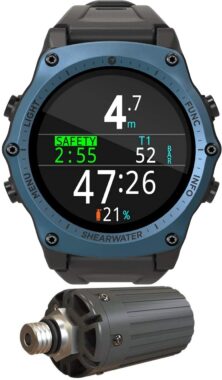
Where to Buy:
The Shearwater Research Teric is a highly sophisticated dive computer that’s been designed specifically with the technical diver in mind.
It features open-circuit and closed circuit Air, Nitrox and Trimix multi gas functionality as well as recreational, gauge, freediving, open-circuit tech and closed-circuit/bail-out modes.
Multiple gas definition preset can be supported with any combo of oxygen, nitrogen and helium. At 500 hours storage, the dive log is rather substantial!
It’s also one of the very few models of dive computer that WON’T lockout after a missed stop or ascent rate violation!
You can configure the settings so that a single press of one of the four buttons will provide access to the many tools it features including a compass, stopwatch, countdown timer.
Data is displayed on the full colour AMOLED display which measures 5.5 x 1.8cm and weighs just 120 grams – the Shearwater Research Teric is as light and compact as a regular watch and it looks damn good on your wrist!
Air integration is optional for all modes from OC Rec to CC/BO. Tank pressure can be displayed to the customisable slots on the main screen or accessed through the underlying info screens.
This is an seriously formidable and impressive dive computer that will suit tec divers needs and is well worth the money.
PROS:
- Tec diving features
- Full Colour Sapphire Crystal Display
- Highly Customisable
- Shows remaining air
CONS:
- Pretty expensive
- Battery lasts about 30 hours
- No heart rate monitor
What the Hell is Air Integration in a Dive Computer anyway?!
In case you’d like to know a little more about what it means for a dive computer to be air integrated – you’re in the right place!
Not all dive computers feature air integration technology. But of those that do, they still require a (separately purchased) wireless transmitter – also known as a tank pod, air integration pod or air integration transmitter.
The air integration transmitter communicates information regarding tank pressure (how much air is in the tank) with the dive computer – it usually does this through radio frequencies although it can also be via sonar technology.
Let’s take a look at one of those air integration transmitters below, in this instance a Suunto air integration transmitter aka Suunto Tank Pod:
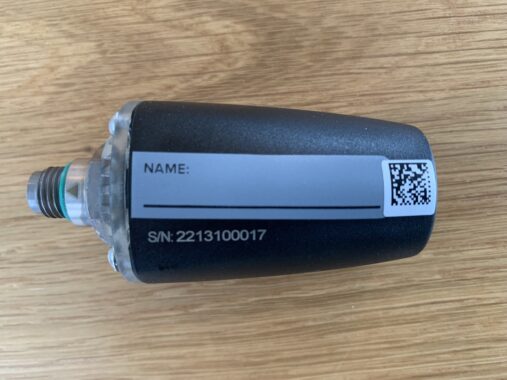
Seems kinda unassuming don’t it?! Almost a surprise you pay several hundred bucks for it, but this is the very thing that allows your dive computer to show you how much air you have left in your tank – and more!
That serial number at the bottom is pretty freakin’ important by the way. When it comes to pairing your dive computer with your air integration transmitter, you’ll want to pair it with the right serial number – otherwise you could end up pairing it to someone elses transmitter – awkward!
Some air integrated dive computers boast of being able to pair to multiple transmitters – in theory this would allow a dive instructor to keep tabs on multiple students air. However, in reality it’s highly unlikely that a dive centres is going to fork out all that money just so their instructor can monitor everyone’s air like that.
Generally speaking, a transmitter produced by one scuba diving gear manufacturer – e.g. Suunto can be paired with any of that brands dive computers (so long as they’re models that feature air integration). For example the Suunto Tank Pod can pair with a Suunto D4i, Suunto D5, Suunto Eon Core, etc. But it can’t to be able to pair with a Garmin MK2i dive computer.
After the air integration transmitter is connected to your dive computer, it’ll usually automatically do this every time you turn your dive computer on. But be sure to check this in settings before you dive!
Let’s backtrack and take a quick look at the sort of box-content you can expect to receive when you buy an air integration transmitter – in this case a Suunto Tank Pod:
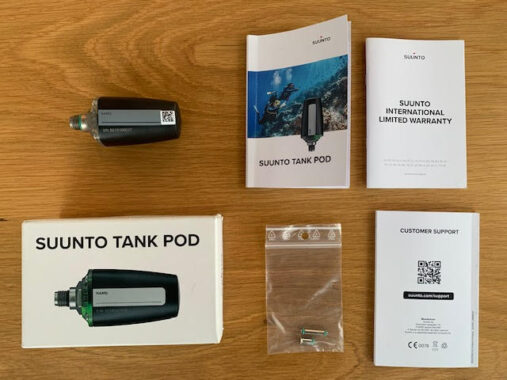
So – you get the wireless transmitter / Suunto Tank Pod, an information leaflet, a warranty and in that little clear baggy you see there are a pair of flow restrictors – the long one is for when you’re connecting the air pod to a high pressure hose (if you have a console dive computer).
The short one is for when you’re connecting the transmitter directly to the first stage of your regulator because you have a wrist dive computer – this is more likely as most dive computers are wrist dive computers.
How to Connect Dive Computer Wireless Transmitter to Regulator First Stage:
We’re glad you asked! Check out the little movie below for a full demonstration. With catchy electro.
So…if you’re going to use an air integration transmitter, you’ll want to have your own scuba regulator as it’s a little fiddly to attach and most dive centres probably won’t want you to do this to their own rental regulators. If you don’t yet have your own scuba regulator – check out our best scuba regulator reviews here!
The information leaflet explains how you can connect the tank pod to your regulator (or high pressure hose) but there’s also an online guide on attaching a Suunto Tank Pod here.
Check out the image below to see what it looks like when an air integration pod is connected to the first stage of a regulator:
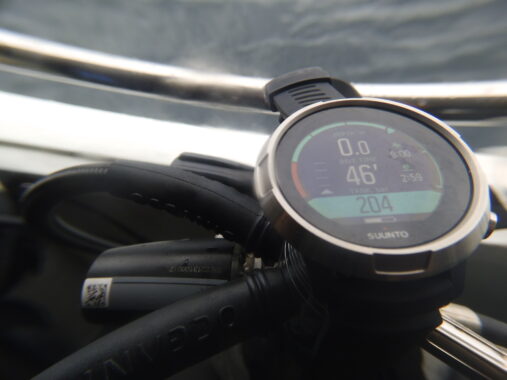
After attaching your tank pod to your regulator or high pressure hose, you’ll really want to avoid it getting knocked – it’s not flimsy but it also ain’t ultra tough. I highly recommend buying a hard case for your scuba diving regulator to keep everything safe – here’s a link to the one I use!
By the way, most air integration transmitters run on user-changeable lithium batteries that normally last 150 – 200 dives.
Ok, moving on… once you’ve attached your wireless transmitter to your regulator (or possibly high pressure hose), and connected it to your dive computer, you will be able to view the air integration information on your dive computer. Let’s take a look at several screenshots of air integration info displayed on the might Suunto D5:

On the lower third of the Suunto D5’S display it’s showing 100 tank bar remaining. If you’re wandering where that beautiful coral in the background was taken by the way – I snapped these photos with my Suunto D5 whilst diving in the red sea – it was awesome! Ok – next photo:
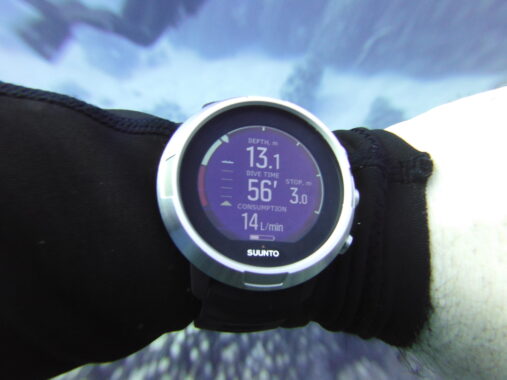
Now the lower third shows air consumption. This is really cool because not only does it let you know how fast you’re getting through air on a dive, it’s also recorded in the logbook. This means you can go through your various dives and see if your air consumption is improving – or getting worse! I love this!!
To cycle between different sets of air integration info – e.g. how much air remains or air consumption rate, you up simply press the lower button of the D5. However, the manner in which you pull up different air integration info will vary between dive computers – but it’s usually ultra simple. Let’s check out yet another photo:
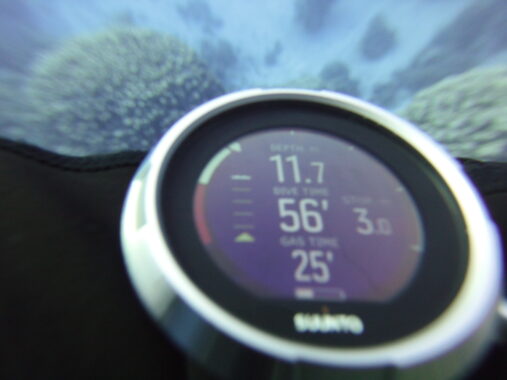
Now we see that in the lower third of my Suunto D5’s display, it is giving remaining air time – i.e. how long before my tank is totally empty! In this instance, it’s telling me I have 25 minutes of remaining gas time – which is based on my air consumption so far throughout the dive.
This is another super handy feature! It uses intelligent Ai to give this prediction. Of course, it can’t account for unforseem circumstance. Perhaps a horny mermaid is about to swim out of the abyss and grab my leg to pull me down – this will likely elevate my heart-rate somewhat and cause me to get through my remaining air quicker than the D5 anticipated. The remaining gas time is just an estimate.
And that’s pretty much it in terms of air integration tech. Depending on which model of dive computer you have, you’ll find that navigation through different air integrated related sets of data may vary whilst very simple air integrated dive computers may only give you remaining and air consumption but not show remaining air time. We’ve mentioned which models of air integrated dive computer can and can’t do this in the reviews above.
Diving Squad Debriefing
In this mighty article we’ve reviewed the absolute best air integrated dive computers on the market whilst also providing a breakdown at the end of everything you need to know about air integration technology.
Diving Squad content is constantly being reviewed and updated so you can rest assured that what you’ve read today reflects the very latest information regarding air integration dive computers in 2024.
We tried to keep things fun and fresh with original photos, real-life user feedback and a lighthearted, friendly approach – we really hope you’ve enjoyed reading and that you feel ready to go forth into the world and purchase your dream air integrated dive computer.
If you have any questions or thoughts, please feel free to reach out to us on the Contact Page. Chow for now!
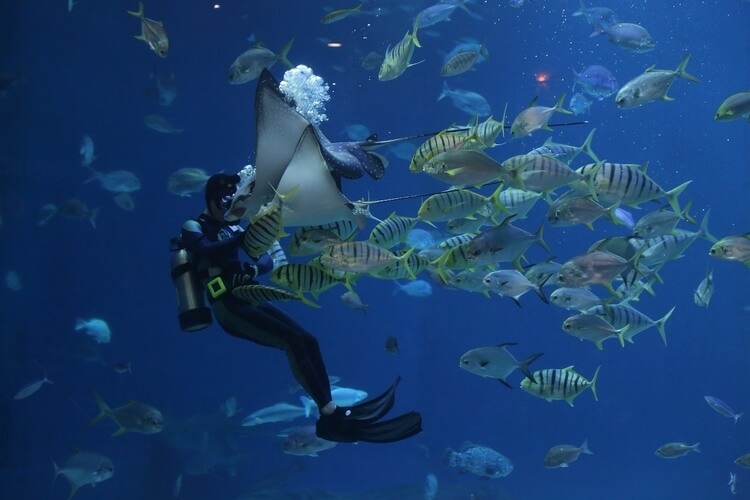
Support the Squad!
We’re part of the Amazon Services LLC Associate Program. If you make a purchase on amazon after clicking a link on Diving Squad, we earn a small commission fee, at no extra cost to yourself.
We are also part of several other affiliate programs so if you click on a Diving Squad affiliate link that results in you booking a liveaboard, booking accommodation, purchasing insurance or buying a product somewhere else, once again – we make a small commission, without it costing you any extra.
It’s funds like that which help us keep this website cool, awesome and ultra sexy whilst continuing to delve out into new corners of the world to gather fresh scuba diving content. Thanks!
A moment’s thought: Diving is not only about exploration, there is an increasing awareness among divers that we owe it to the ocean to do our part to look after it.
David Attenborough said, “I wish the world was twice as big and half of it was still unexplored.” For many of us, this is true. The world is double its size and the parts that are waiting to be explored by us are under the water’s surface.
